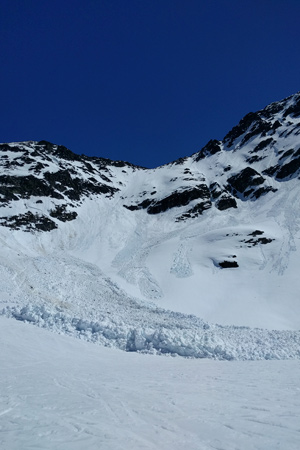
As spring arrives in the mountains, so too does the increased likelihood of point release avalanches due to warming temps. [Photo] Ruth Hartnup
As the spring approaches, many of us turn our attention to steeper, more technical lines higher in the mountains. The layers of snow that formed throughout the winter begin to gain strength and the avalanche problem is less complicated—it’s ski mountaineering season! But as the temperatures climb, wet avalanches become a more regular, primary concern.
Wet, loose snow avalanches—sometimes called “point releases”—occur when the bonds between the grains of snow loosen to a point where they begin to slide down the mountain. As they go, they collect more grains, continuing and spreading until the slope flattens. The “point” could be below a warm rock, where a cornice sheds a piece, or where your skis touch the snow, which is why their path looks like an “A.” They are slow moving, but have a lot of mass and can do a lot of damage, and while some people downplay their significance, imagine being run over by a train—even if it’s moving slowly, it’s going to suck.
When I started ski mountaineering, we placed a lot of emphasis on turnaround time—at some time during the day, the slope would become unstable and we’d need to get out of there. Someone would always say something like, “Hey, I think we should be off the slope by 11 a.m.” Anticipating the loosening of bonds and not being there when things start moving is the best way to stay out of trouble, but the clock is not the best tool for making this decision. Instead, keep the following observations in mind.
Temperature: Once the temperature goes above freezing, the bonds between grains begin to loosen. The warmer the temperature, the faster this happens. Carrying a thermometer in the spring isn’t a bad idea.
Solar: Even if the air temperature is below freezing, the sun can warm the snow. The greater the sun’s intensity, the more rapid the warming. Keep in mind that high, thin clouds can magnify this effect. Your skin is a really good gauge as well. If you feel like you are being baked, so is the snow. This can be a very fast process, and if it happens right after a storm, look for the new snow to start moving very soon.
Porosity of Snow: If the snow is more winter-like (lighter and drier) the temperature and sun will have more dramatic effects than if the snow is dense and hard. The transition from winter to spring often involves substantial avalanches. New snow from spring storms will be easily affected by radiation, which is why avalanches often occur as soon as the sun comes back out. Conversely, the patch of snow that is lying around in July is unlikely to slide even if the temperatures climb into the 70s.
Wet Snow: Snow is considered “wet” when you picked it up with a gloved hand, squeeze it into a ball and water drips out, meaning there’s free water in the snowpack. And if there is free water in the snow, it is time to get off that slope.
Boot Penetration: When you put all your weight on one foot, without a ski on, in an area of undisturbed snow, how far does it sink? This is your boot penetration. Only sinking an inch or two makes for ideal skiing conditions. If you sink in to your boot tops or higher, the snow has passed its prime and is now much more likely to avalanche.
Time: Time is helpful if you have an observation from the very recent past. (For example: certain aspects began to slide at 11 a.m. yesterday and today’s weather will be very similar.) Any charts or such, however, are just rules of thumb, and observations are better tools.
Establishing a “turn around time” for spring skiing objectives isn’t really the best practice. Instead, ask yourself all these questions when dealing with a wet snow avalanche problem: Is it above freezing? How strong is the sun? How porous is the snow? Is there free water present? How deeply are you sinking while walking? If you want to stay safe and give yourself the best shot of skiing primo corn, make real-time observations that give you solid information.
—
Donny Roth is an AMGA-certified ski guide and professional skier. He writes about his adventures at independent-descents.com. Learn more about skiing with him in Chile at chile-powder-adventures.com










Related posts: